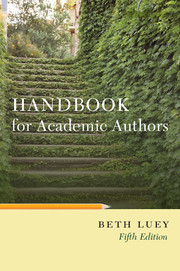Book contents
- Frontmatter
- Contents
- Illustrations
- Preface to the Fifth Edition
- Preface to the Fourth Edition
- Preface to the Third Edition
- Preface to the Second Edition
- Preface to the First Edition
- Chapter 1 The Publishing Partnership
- Chapter 2 Journal Articles
- Chapter 3 Revising a Dissertation
- Chapter 4 Finding a Publisher for the Scholarly Book
- Chapter 5 Working with Your Publisher
- Chapter 6 Multiauthor Books and Anthologies
- Chapter 7 Finding a Publisher for the College Textbook
- Chapter 8 Working with Your Textbook Publisher
- Chapter 9 Books for General Readers
- Chapter 10 The Mechanics of Authorship
- Chapter 11 Costs and Prices
- Chapter 12 Born Digital
- Bibliography
- Index
Chapter 10 - The Mechanics of Authorship
Published online by Cambridge University Press: 02 December 2010
- Frontmatter
- Contents
- Illustrations
- Preface to the Fifth Edition
- Preface to the Fourth Edition
- Preface to the Third Edition
- Preface to the Second Edition
- Preface to the First Edition
- Chapter 1 The Publishing Partnership
- Chapter 2 Journal Articles
- Chapter 3 Revising a Dissertation
- Chapter 4 Finding a Publisher for the Scholarly Book
- Chapter 5 Working with Your Publisher
- Chapter 6 Multiauthor Books and Anthologies
- Chapter 7 Finding a Publisher for the College Textbook
- Chapter 8 Working with Your Textbook Publisher
- Chapter 9 Books for General Readers
- Chapter 10 The Mechanics of Authorship
- Chapter 11 Costs and Prices
- Chapter 12 Born Digital
- Bibliography
- Index
Summary
Describing the rhythm method of birth control in her latest book,…sex therapist Ruth Westheimer, Ph.D., incorrectly tells her readers that “the safe times [for sexual intercourse] are the week before and the week of ovulation.” While proofreading, “I read the word ‘unsafe’ in my mind,” says the tiny tycoon. “These things do happen.”
Newsweek, January 13, 1986Many of the tasks involved in publishing are mechanical, uninteresting, and frustrating. They are also crucial. This chapter does not make manuscript preparation, proofreading, indexing, and the like painless, but it will help the diligent author perform these jobs efficiently and well. If you do not want to fulfill any of these functions, your publisher can help you find people to do them for you, but the cost of delegating all this work would probably be prohibitive. In many cases, too, the author is the best-qualified proofreader and indexer.
Manuscript Preparation
Almost all academic authors now use computers to prepare manuscripts for articles and books. Computers are easier to use than typewriters, and they provide the author with a great deal of assistance in writing and indexing. Publishers prefer to work with electronic material because it makes editing and design easier and saves time and money on typesetting. Textbook publishers are less likely to require electronic manuscripts because of the complex layout and design of their books, and because typesetting is a small percentage of their production costs. They may well want to use electronic manuscripts for supplementary materials, such as study guides, however.
- Type
- Chapter
- Information
- Handbook for Academic Authors , pp. 173 - 206Publisher: Cambridge University PressPrint publication year: 2009



